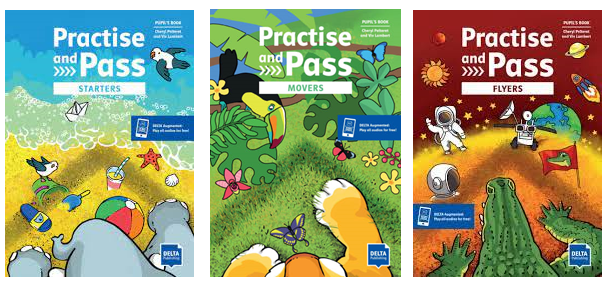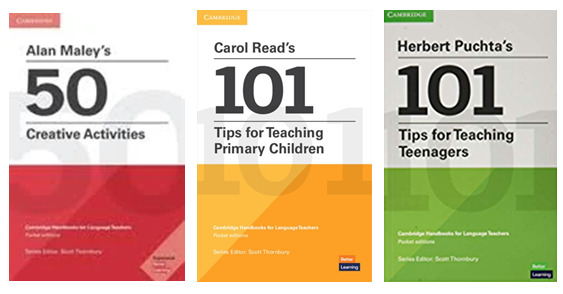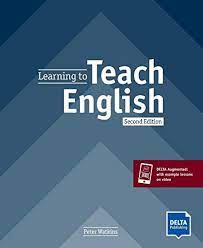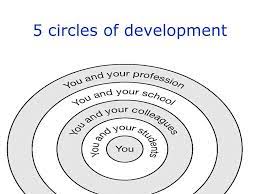Short Book Reviews
Hanna Kryszewska is a teacher, teacher trainer, trainer of trainers. She is a senior lecturer at the University of Gdańsk, Poland. She is co-author of resource books: Learner Based Teaching, OUP, Towards Teaching, Heinemann, The Standby Book, CUP, Language Activities for Teenagers, CUP, The Company Words Keep, DELTA Publishing, and a course book series for secondary schools: ForMat, Macmillan. She is also co-author of a video-based teacher training course: Observing English Lessons, and online course for Orient Black Swan on 21st Century Skills and Teaching the whole person: Humanising language teaching. Hania is a Pilgrims trainer and editor of HLT Magazine.
E-mail: hania.kryszewska@pilgrimsteachertrainig.eu

Practice and Pass. Starters. Pupil's Book + Augmented. V. Lambert and Ch. Pelteret. (2021) DELTA Publishing. ISBN-978-3-12-501770-2, pp 72. This is one of the three-part series of books preparing for the various YLE Cambridge exams. The books are based on the Cambridge English Qualifications: Dragons, Elephants, Lions, Tigers and Alligators. The book in question is the Pre-A1 Level (Elephants). It is a fun step-by-step activity-based book for children aged 7-9 who are preparing for the Cambridge Young Learners English Test: Starters. According to the authors the three steps to success are summed up by these key words: Prepare, Practise and Pass. So the book follows three stages: Prepare: Learn the language you need!, Practise: Practise the language and task!, and Pass: Take the test and show what you can do! Get the certificate! The book shows young learners what to expect in the test by following a discreet preparation checklist. It teaches words and phrases in a topic-based way and relevant tasks. The teacher’s book offers key phrases for the speaking test, tips for the test and one complete practice test, There are also online practice quizzes a digital edition with LMS for students and many more exciting features.

Cambridge Handbooks for Language Teachers, Pocket editions. Series editor S. Thornbury. This is an absolutely charming teacher development series. The books are short, informative, food for thought, and can be easily carried in a handbag or jacket pocket due to their A5 size and virtually no weight at all. To the best of my knowledge there are around 15 titles published in this series. In this review we will look at three – published2018, 2020 and 2021 which among others show how over the years the series has developed.
Alan Maley’s 50 Creative Activities. (2018) Cambridge. ISBN-978-1-108-45776-7, pp 107. This is a collection of very inspiring activities for the creative classroom. Alan has always been interested in creativity in the classroom as well as in being creative as a teacher and human being. This approach leads also to critical thinking, exploration, openness to new ideas, and appreciation of divergent/ lateral thinking, or thinking outside the box. These days considered as one of the most important 21st century skills. Look inside.
Carol Read’s 100 Tips for Teaching Primary Children. (2020) Cambridge. ISBN-978-1-108-74422-5, pp 139. Carol Read shares her experience and knowledge on how to teach kids aged 6-12. She looks not only at language learning but also the children’s general development. The book is a good mix of methodological tips and practical ideas. Look inside.
Herbert Puchta’s 100 Tips for Teaching Teenagers. (2021) Cambridge. ISBN-978-1-108-73875-0, pp 116. Teaching teenagers can be a difficult task but at the same time very rewarding when you get it right. Herbert Puchta is the author of coursebooks for teenagers and resource books for those who teach in this age group. This pocketbook combines the essence of recent research and findings on teaching this age group which are reflected in and implemented in practical activities. The main message is trying to understand teenagers, creating a positive classroom atmosphere, and helping teenagers on their way to maturity.
Teaching Teens. Speaking Activities. Ch. Straukamp. (2022) DELTA Publishing. ISBN-978-3-12-501737-5, pp 120. This book is aimed at learners who are not exceptionally strong at speaking, at classes in which students speak for a short and limited time, and at teachers who want to avoid frontal teaching and a lot of Teacher Talking Time (TTT) at the expense of Student Talking Time (STT). The book is full of tip, tricks and activities that will help you overcome the various hurdles when you are trying to get everyone in the class to speak. In the book you will first find characteristics of activities that involve milling around, drilling, pictures and images, dialogues, writing, and phonetics. The 17 activities which then follow are fun, the procedure is easy to follow, and the necessary materials and worksheets are at the ned of the book, of course photocopiable I couldn’t find information about the level the activities are suitable for. I would say good pre-intermediate or intermediate, but of course they could be adapted for higher levels

Learning to Teach English. Second Edition. P. Watkins. (2021) DELTA Publishing. ISBN-978-3-12-501684-2, pp 168. This book has been published in the Learning to … DELTA series. The aim of the series is to look at various aspects of teaching English in greater detail. In this book the author looks at teaching English in general; it is an introduction to teaching English as a foreign language. The areas covered in the book are predictable such as for example: roles of teachers and learners, teaching the four language skills, the four language systems (grammar, vocabulary, phonology and discourse), planning lessons, professional development etc. The book looks a bit dry but it gets much more lively in the appendix section, and I suppose there is so much more in the free DELTA Augmented app where you can access digital extras which accompany the book. The blurb on the cover describes the addressees this book as suitable for pre-service teachers on foundation courses such as Cambridge English CELTA and TKT or Trinity College London’s CertTESOL – which are mainly aimed at native speakers of English who want to become EFL teachers. In other words the book aims at a similar audience as Jeremy Harmer’s How to Teach English (Longman, Pearson) or The Oxford ESOL Handbook by Philida Schellekens (Oxford). Personally, I believe that it would be useful for any teacher trainer who delivers pre-service courses in any country of the world.
How Languages are Learned. Fifth Edition. P.M. Lightbrown and N. Spada. (2021) Oxford. ISBN-978-0-19-440629-1, pp 280. The book appeared in the Oxford Handbook for Teachers series. It is a highly regarded series which responds to the interests and needs of teachers. It can be used for Continuous Professional Development (CPD) or on in-service teacher training courses as an inspiration for trainers and background reading for the participants. The addressed topics are very relevant to language learning e.g. language learning in early childhood, second language learning, individual differences in second language learning, various psychological perspectives for looking at language learning ( such as behaviourist, innatist, cognitive, sociocultural etc), observing learning and teaching, second language learning in the class, and finally revisiting the popular ideas about language learning. I am unable to compare all of this revised fifth edition of the book, but I have to say that as a seasoned EFL trainer, I started reading the book from the last section. The 18 findings of recent research such as learning through imitation, role of correction, ideas on language interference and many other are pretty similar to the third edition, and yet they will be a great starting point for discussions among in-service teachers, and may continue to map out directions for CPD.
Zest for Learning. Developing curious learners who relish real world challenges. B. Lucas and E. Spencer. (2020) Crown House Publishing Limited. ISBN- 978-178583401-1 pp 278. The book has appeared in the series Pedagogy for a Changing World. This is another publication reviewed in HLT which comes from beyond our EFL realm. As Duncan Foord said in The Developing Teacher we learn from and develop through self-reflection, our learners, our colleagues, other people in your school, and finally other people in the profession.

My encounter with this book is the last case. I feel I am learning a lot from other educators and teachers, who like me are in the teaching profession but not EFL. What is ‘zest for learning’? In a nutshell it is enthusiasm and energy that students bring into class. It is a flame that can easily be dowsed, and then needs rekindling, or in the worst case scenario, the fire needs to be started. There are different aspects of this ‘zest for learning’. It may be understanding and catering for the changing roles of schools, prioritising capabilities, sowing seeds for lifelong learning, or highlighting key learning experiences that bring about lasting change. The book looks at knowledge and flourishing, presents a framework for the approach (balanced, curious, purposeful), presents ‘signature learning experiences’ and some promising practices, explores ‘brave’ leadership and opposed to ‘plain’ leadership, and ends with an A-Z of ideas in the form of a list (although not quite A-Z).
Please check the Pilgrims f2f courses at Pilgrims website.
Please check the Pilgrims online courses at Pilgrims website.
Training Teachers to Write Materials
John Hughes, UKFrom ELI Online: Digital Literacies in ELT - A Busy Digital World
Andy Cowle, UKTeaching English with Authentic Video - New CPD Course from Ready to Run and NILE
Short Book Reviews
Hanna (Hania) Kryszewska, PolandFrom a Retired TEFLer: Helleyer’s Line
Philip Prowse, UK